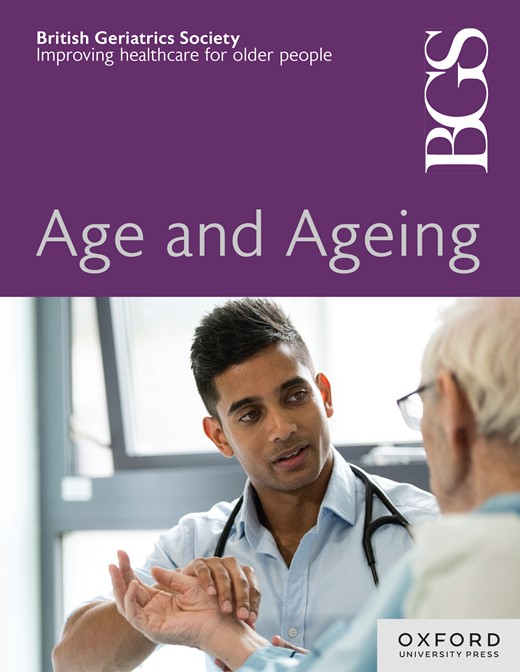The impact of a multi-component hospital avoidance programme in residential aged care homes: a stepped-wedge cluster randomised trial
IF 7.1
2区 医学
Q1 GERIATRICS & GERONTOLOGY
引用次数: 0
Abstract
Objectives To investigate if a multi-component hospital avoidance intervention would reduce hospital bed days in residential aged care (RAC) homes. Design Prospective stepped-wedge cluster randomised trial with usual care and intervention phases. Setting Eleven RAC homes in Queensland, Australia. Participants The intervention targeted all nursing staff and personal care workers within the participating RAC homes. Outcome data were collected for all residents living in the participating RAC homes at any time throughout the trial period. Intervention The intervention comprised four core components: face-to-face training sessions with all nursing staff and personal care workers; provision of diagnostic medical equipment; decision support tools and embedded implementation facilitation and support. Main outcome measures The primary outcome was the number of hospital bed days per 100 resident days in RAC homes. Secondary outcomes assessed emergency department (ED) transfers, subsequent admissions to hospital and hospital length of stay. Results No statistically significant intervention effects were observed across the reported outcomes. Exposure to the early detection of deterioration in elderly residents intervention was associated with a 27% relative increase in the primary outcome of hospital bed days (Estimate, 95% CI: 1.13, 0.93–1.74, P-value = 0.137). There was an 8% reduction in ED transfers (Estimate, 0.92: 0.74–1.14, P-value = 0.462) and a 10% increase in hospital admissions (Estimate, 1.10, 95% CI: 0.84–1.44, P-value = 0.486). For residents admitted to the hospital, the expected length of stay increased from 4.2 to 4.4 days (Estimate: 1.04; 95% CI: 1.00–1.07; P-value = 0.055). Conclusions Whilst not statistically significant, findings indicate that the intervention was associated with fewer ED transfers, but increased hospital admissions and overall hospital bed days. Programme implementation was impacted by major contextual barriers, notably the COVID-19 pandemic, which contributed to pressures on staffing and workload. Trial registration Australia New Zealand Clinical Trial Registry, ACTRN12620000507987 (registered 23rd April 2020).多成分住院避免计划在住宅老年护理之家的影响:一项楔步聚类随机试验
目的探讨多成分住院回避干预是否会减少住院老年护理(RAC)家庭的住院天数。设计前瞻性楔形步聚群随机试验,分为常规护理和干预阶段。在澳大利亚昆士兰州设置11个RAC住宅。干预的对象是参与RAC家庭的所有护理人员和个人护理人员。在整个试验期间的任何时间,收集了居住在参与RAC家庭的所有居民的结果数据。干预措施干预措施包括四个核心部分:对所有护理人员和个人护理工作者进行面对面的培训;提供诊断医疗设备;决策支持工具和嵌入式实施促进和支持。主要结局指标主要结局指标是RAC家庭每100个住院日的住院天数。次要结果评估了急诊科(ED)转院、随后入院和住院时间。结果在报告的结果中没有观察到统计学上显著的干预效果。在老年居民干预中早期发现病情恶化与住院天数的主要结局相对增加27%相关(估计95% CI: 1.13, 0.93-1.74, p值= 0.137)。急症转移减少了8%(估计,0.92:0.74-1.14,p值= 0.462),住院率增加了10%(估计,1.10,95% CI: 0.84-1.44, p值= 0.486)。入院居民的预期住院时间从4.2天增加到4.4天(估计值:1.04;95% CI: 1.00-1.07; p值= 0.055)。结论:虽然没有统计学意义,但研究结果表明,干预与急诊科转移减少有关,但增加了住院人数和总住院天数。方案实施受到重大背景障碍的影响,特别是COVID-19大流行,这加剧了人员配置和工作量的压力。澳大利亚新西兰临床试验注册中心,ACTRN12620000507987(注册于2020年4月23日)。
本文章由计算机程序翻译,如有差异,请以英文原文为准。
求助全文
约1分钟内获得全文
求助全文
来源期刊

Age and ageing
医学-老年医学
CiteScore
9.20
自引率
6.00%
发文量
796
审稿时长
4-8 weeks
期刊介绍:
Age and Ageing is an international journal publishing refereed original articles and commissioned reviews on geriatric medicine and gerontology. Its range includes research on ageing and clinical, epidemiological, and psychological aspects of later life.
 求助内容:
求助内容: 应助结果提醒方式:
应助结果提醒方式:


